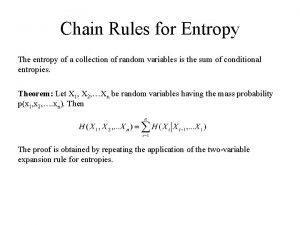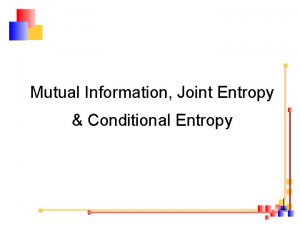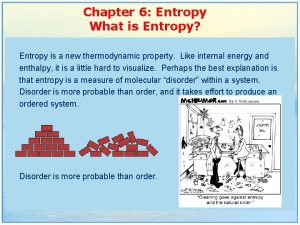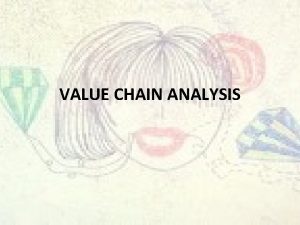Chain Rules for Entropy The entropy of a











- Slides: 11

Chain Rules for Entropy The entropy of a collection of random variables is the sum of conditional entropies. Theorem: Let X 1, X 2, …Xn be random variables having the mass probability p(x 1, x 2, …. xn). Then The proof is obtained by repeating the application of the two-variable expansion rule for entropies.

Conditional Mutual Information We define the conditional mutual information of random variable X and Y given Z as: Mutual information also satisfy a chain rule:

Convex Function We recall the definition of convex function. A function is said to be convex over an interval (a, b) if for every x 1, x 2 (a. b) and 0 λ ≤ 1, A function f is said to be strictly convex if equality holds only if λ=0 or λ=1. Theorem: If the function f has a second derivative which is non-negative (positive) everywhere, then the function is convex (strictly convex).

Jensen’s Inequality If f is a convex function and X is a random variable, then Moreover, if f is strictly convex, then equality implies that X=EX with probability 1, i. e. X is a constant.

Information Inequality Theorem: Let p(x), q(x), x χ, be two probability mass function. Then With equality if and only if for all x. Corollary: (Non negativity of mutual information): For any two random variables, X, Y, With equality f and only if X and Y are independent

Bounded Entropy We show that the uniform distribution over the range χ is the maximum entropy distribution over this range. It follows that any random variable with this range has an entropy no greater than log|χ|. Theorem: H(X)≤ log|χ|, where|χ| denotes the number of elements in the range of X, with equality if and only if X has a uniform distribution over χ. Proof: Let u(x) = 1/|χ| be the uniform probability mass function over χ and let p(x) be the probability mass function for X. Then Hence by the non-negativity of the relative entropy,

Conditioning Reduces Entropy Theorem: with equality if and only if X and Y are independent. Proof: Intuitively, theorem says that knowing another random variable Y can only reduce the uncertainty in X. Note that this is true only on the average. Specifically, H(X|Y=y) may be greater than or less than or equal to H(X), but on the average

Example Let (X, Y) have the following joint distribution X Y 1 2 0 3/4 1/8 Then H(X)=(1/8, 7/8)=0, 544 bits, H(X|Y=1)=0 bits and H(X|Y=2)=1 bit. We calculate H(X|Y)=3/4 H(X|Y=1)+1/4 H(X|Y=2)=0. 25 bits. Thus the uncertainty in X is increased if Y=2 is observed and decreased if Y=1 is observed, but uncertainty decreases on the average.

Independence Bound on Entropy Let X 1, X 2, …Xn are random variables with mass probability p(x 1, x 2, …xn ). Then: With equality if and only if the Xi are independent. Proof: By the chain rule of entropies: Where the inequality follows directly from the previous theorem. We have equality if and only if Xi is independent of X 1, X 2, …Xn for all i, i. e. if and only if the Xi’s are independent.

Fano’s Inequality Suppose that we know a random variable Y and we wish to guess the value of a correlated random variable X. Fano’s inequality relates the probability of error in guessing the random variable X to its conditional entropy H(X|Y). It will be crucial in proving the converse to Shannon’s channel capacity theorem. We know that the conditional entropy of a random variable X given another random variable Y is zero if and only if X is a function of Y. Hence we can estimate X from Y with zero probability of error if and only if H(X|Y) = 0. Extending this argument, we expect to be able to estimate X with a low probability of error only if the conditional entropy H(X|Y) is small. Fano’s inequality quantifies this idea. Suppose that we wish to estimate a random variable X with a distribution p(x). We observe a random variable Y that is related to X by the conditional distribution p(y|x).

Fano’s Inequality From Y, we calculate a function g(Y) = X^ , where X^ is an estimate of X and takes on values in X^. We will not restrict the alphabet X^ to be equal to X, and we will also allow the function g(Y) to be random. We wish to bound the probability that X^ ≠ X. We observe that X → Y → X^ forms a Markov chain. Define the probability of error: Pe = Pr{X^ = X}. Theorem: The inequality can be weakened to: Remark: Note that Pe = 0 implies that H(X|Y) = 0 as intuition suggests.
 Food chain sequence
Food chain sequence Chain rule for entropy
Chain rule for entropy Kontinuitetshantering
Kontinuitetshantering Typiska drag för en novell
Typiska drag för en novell Nationell inriktning för artificiell intelligens
Nationell inriktning för artificiell intelligens Returpilarna
Returpilarna Varför kallas perioden 1918-1939 för mellankrigstiden?
Varför kallas perioden 1918-1939 för mellankrigstiden? En lathund för arbete med kontinuitetshantering
En lathund för arbete med kontinuitetshantering Underlag för särskild löneskatt på pensionskostnader
Underlag för särskild löneskatt på pensionskostnader Tidbok yrkesförare
Tidbok yrkesförare Anatomi organ reproduksi
Anatomi organ reproduksi Vad är densitet
Vad är densitet





















